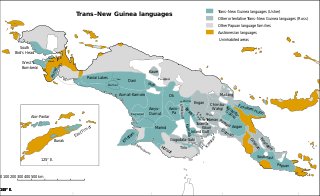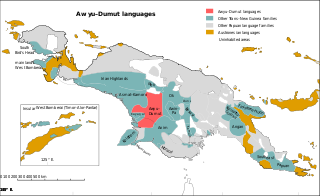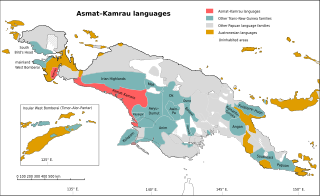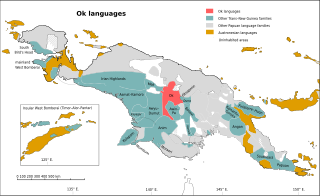Related Research Articles

Trans–New Guinea (TNG) is an extensive family of Papuan languages spoken on the island of New Guinea and neighboring islands, a region corresponding to the country Papua New Guinea as well as parts of Indonesia.
The Nimboran languages are a small family of Papuan languages, spoken in the Grime River and Nawa River watershed in Jayapura Regency, that had been part of Stephen Wurm's Trans–New Guinea proposal. However, when proto-Nimboran pronouns are reconstructed (*genam "I" and kom or komot "thou"), they have little resemblance to the proto-TNG pronouns *na and *ga. Usher places them in a North Papuan stock that resembles Cowan's proposal.
The Burmeso language – also known as Taurap – is spoken by some 300 people in Burmeso village along the mid Mamberamo River in Mamberamo Tengah subdistrict, Mamberamo Raya Regency, Papua province, Indonesia. It is surrounded by the Kwerba languages to the north, the Lakes Plain languages to the south, and the East Cenderawasih Bay languages to the west.

The Greater Awyu or Digul River languages, known in earlier classifications with more limited scope as Awyu–Dumut (Awyu–Ndumut), are a family of perhaps a dozen Trans–New Guinea languages spoken in eastern West Papua in the region of the Digul River. Six of the languages are sufficiently attested for a basic description; it is not clear how many of the additional names may be separate languages.

The Asmat – Kamrau Bay languages are a family of a dozen Trans–New Guinea languages spoken by the Asmat and related peoples in southern Western New Guinea. They are believed to be a recent expansion along the south coast, as they are all closely related, and there is little differentiation in their pronouns.

The Central and South New Guinea languages (CSNG) are a proposed family of Trans–New Guinea languages (TNG). They were part of Voorhoeve & McElhanon's original TNG proposal, but have been reduced in scope by half in the classification of Malcolm Ross. According to Ross, it is not clear if the pronoun similarities between the four remaining branches of Central and South New Guinea are retentions for proto-TNG forms or shared innovations defining a single branch of TNG. Voorhoeve argues independently for an Awyu–Ok relationship, and Foley echoes that Asmat may be closest to Awyu and Ok of the TNG languages. Regardless, the four individual branches of reduced Central and South New Guinea are themselves clearly valid families.

The Mek languages are a well established family of Papuan languages spoken by the Mek peoples. They form a branch of the Trans–New Guinea languages (TNG) in the classifications of Stephen Wurm (1975) and of Malcolm Ross (2005).

The Kamula–Elevala languages are a small family of the Trans–New Guinea languages spoken in the region of the Elevala River.

The Gogodala–Suki or Suki – Aramia River languages are a small language family of Papua New Guinea, spoken in the region of the Aramia River.

The Mombum languages, also known as the Komolom or Muli Strait languages, are a pair of Trans–New Guinea languages, Mombum (Komolom) and Koneraw, spoken on Komolom Island just off Yos Sudarso Island, and on the southern coast of Yos Sudarso Island, respectively, on the southern coast of New Guinea. Komolom Island is at the southern end of the Muli Strait.

The Ok languages are a family of about a dozen related Trans–New Guinea languages spoken in a contiguous area of eastern Irian Jaya and western Papua New Guinea. The most numerous language is Ngalum, with some 20,000 speakers; the best known is probably Telefol.

The East Strickland or Strickland River languages are a family of Papuan languages.
Momuna (Momina), also known as Somahai, is a Papuan language spoken in Yahukimo Regency, Highland Papua and Asmat Regency, South Papua, Indonesia.

The Yam languages, also known as the Morehead River languages, are a family of Papuan languages. They include many of the languages south and west of the Fly River in Papua New Guinea and Indonesian West Papua.
Suki is a Gogodala-Suki language spoken by about 3500 people several miles inland along the Fly River in southwestern Papua New Guinea.

Morori is a moribund Papuan language of the Kolopom branch of the Trans–New Guinea family. It is separated from the other Kolopom languages by the intrusive Marind family. All speakers use Papuan Malay or Indonesian as L2, and many know Marind.

Uhunduni, also known as Damal (Damal-kal) and Amung (Amung-kal) after two of its dialects, is the language of the Amung people and Damal people. It is a Trans–New Guinea language that forms an independent branch of that family in the classification of Malcolm Ross (2005). However, it is treated as an isolate by Palmer (2018). This language family is also called Ingkipilu in a classification by Anton Moeliono. The word Damal came from the Dani people, while Uhunduni came from the Moni people.

Mor is a nearly extinct Trans–New Guinea language of Indonesia. It is spoken along the Budidi River and the Bomberai River on the Bomberai Peninsula.

Sumuri or Sumeri is a language spoken in Sumuri District, Teluk Bintuni Regency on the Bomberai Peninsula by about a thousand people.
Shiaxa (Sjiagha) and Yenimu, together known as South Awyu, are a Papuan language or languages of Papua, Indonesia. Whether they constitute one language or two depends on one's criteria for a 'language'. The two varieties are,
References
- ↑ Mandobo Bawah at Ethnologue (18th ed., 2015) (subscription required)
Mandobo Atas at Ethnologue (18th ed., 2015) (subscription required) - ↑ Voorhoeve, C. L. (2001). Proto-Awyu-Dumut phonology II. In Andrew Pawley and Malcolm Ross and Darrell Tryon (eds.), The Boy from Bundaberg: Studies in Melanesian Linguistics in Honor of Tom Dutton: Canberra: Research School of Pacific and Asian Studies, Australian National University. pp. 361–381.
- ↑ Pawley, Andrew (2012). Hammarström, Harald; van den Heuvel, Wilco (eds.). "How reconstructable is proto Trans New Guinea? Problems, progress, prospects". History, Contact and Classification of Papuan Languages (Language & Linguistics in Melanesia Special Issue 2012: Part I). Port Moresby, Papua New Guinea: Linguistic Society of Papua New Guinea: 88–164. hdl:1885/38602. ISSN 0023-1959.
- ↑ McElhanon, Kenneth A. AND C.L. Voorhoeve. 1970. The Trans–New Guinea Phylum: explorations in deep-level genetic relationships. Canberra: Pacific Linguistics.